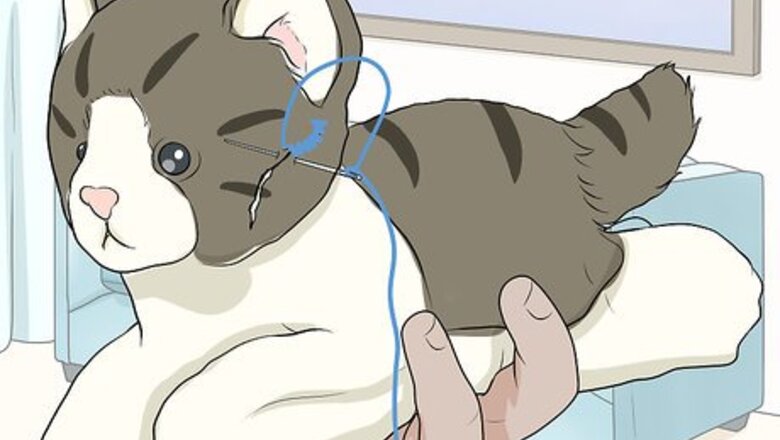
views
Preserving and Storing Stuffed Toys
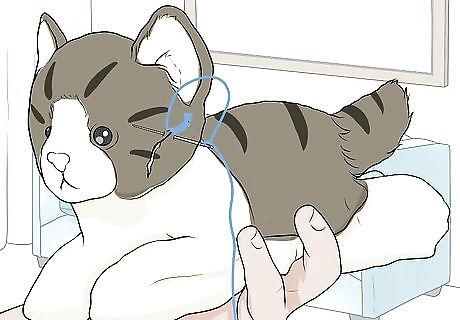
Repair rips and tears. Before storing your stuffed animals for long periods, it’s a good idea to clean them first. But before cleaning them, you want to make sure that any rips or tears are repaired so that the animal doesn’t get destroyed during the cleaning process. Take a needle and thread that’s as close to the color of the animal as you can get. Thread the needle and tie a knot at one end of the thread. Starting at one end of the rip, push the needle up through the underside of the rip to lock the thread in place on the underside of the fabric. Then use the needle to push the thread from the material on one side of the rip to the other in a straight line. Move down and make another stitch. Continue making slip stitches like this until the rip is repaired. Don’t forget to sew and secure eyes, bows, and other features back on if they’ve fallen off.
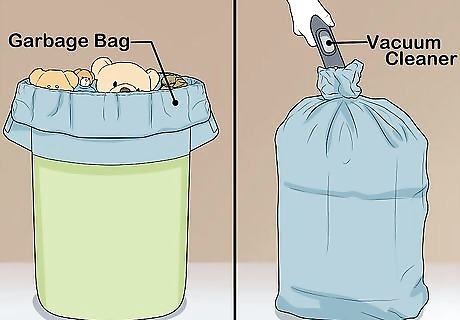
Vacuum the animals. To remove dust, dirt, mites, allergens, and other particles from the stuffed animals, you want to vacuum them periodically, and always before they go into storage. Place several medium to large sized stuffed animals in a large garbage bag. Insert the nozzle of a vacuum cleaner into the bag and seal the bag around the nozzle. Turn on the vacuum cleaner and let it suck out all the air, dust, and dirt. When you're finished, you may need to re-fluff the animals if the stuffing has lost some shape in the process. To vacuum smaller toys, hold them in your hand and use a nozzle attachment of the appropriate size to suck up dirt and dust.
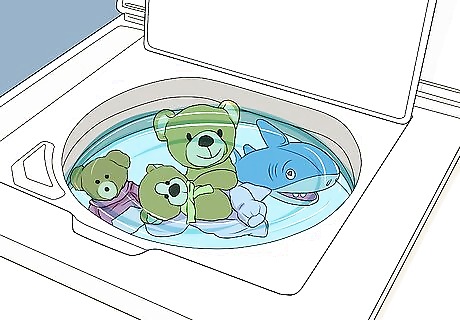
Clean the animals. Depending on how old or delicate your animals are, you may be able to machine wash or hand wash them, or you can clean them with baking soda. Check the care labels on the animals before choosing which method to use. For machine washable toys, place individual animals in mesh laundry bags or stuff them into pillow cases to protect them from snags. Wash them on the delicate or hand wash cycle if it’s available, and use a mild detergent and cold water. To hand wash animals, fill a sink with cool water and add one tablespoon (15 ml) of mild laundry detergent. Immerse the toy in the water and gently agitate the water and rub the fur to remove dirt. Rinse in a fresh sink of clean water to remove the excess detergent. To clean animals with baking soda, place one animal at a time in a plastic bag or pillow case. Depending on the size of the animal, use one tablespoon (15 g) to one-quarter cup (60 g) of baking soda to cover the animal with a light dusting. Close the bag and give it a good shake. Let the animal sit in the baking soda for half an hour, and then use a damp towel to wipe off dirt and excess baking soda.
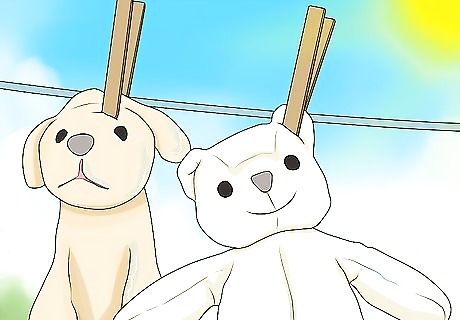
Dry the toys. Wrap each toy in a towel and gently press out the extra water. If the animals have lost any of their shape during the cleaning process, use your hands to fluff them out and reshape the stuffing. To dry the animals, you can: Hang them on a clothesline in the sun. This is ideal for all toys, but it’s especially important for older toys that may be flammable and can't go in the dryer. Let them air dry on a towel. Make sure you turn them over periodically so the air can reach all the sides. Be sure the animals are completely dry before storing them. Put dryer-safe animals in the dryer. Use a low-heat setting and add a few towels to the load to help protect the animals from the tumbling.
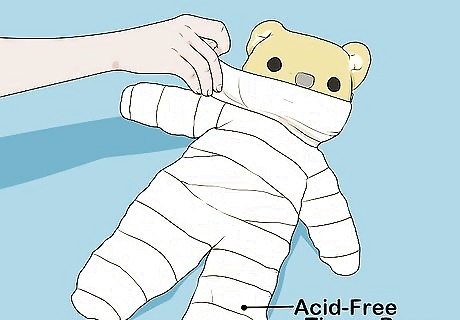
Wrap the animals. To help protect animals that are going to be stored for long periods, especially antique toys, wrap them individually in acid-free tissue paper, which will help to preserve them. Acid-free paper can be purchased from library suppliers, online, or at most craft stores.
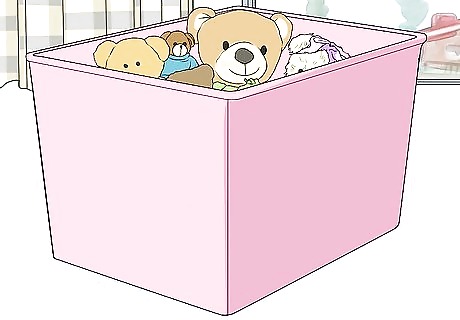
Transfer the animals to plastic storage bins. Lidded plastic totes are ideal for organizing and storing stuffed toys because they can be stacked on top of each other, they keep out pests that could damage the animals, and they allow airflow inside, which prevents mold and mildew growth. You can further prevent mold and mildew problems by storing the bins in a dry location. To prevent damage and crushed fur, don’t overstuff the bins.
Organizing Toy Collections
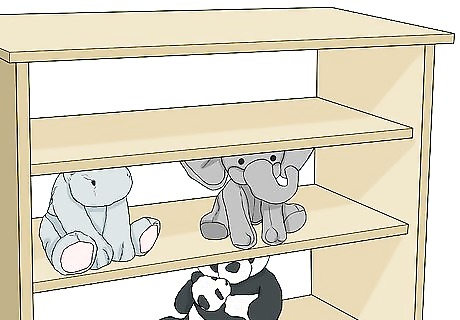
Display them on shelves. Storing stuffed animals isn’t always about putting them away for the long haul, and sometimes you just need a solution that will help you organize and store toys to keep them off the floor and out of the way. Built-in or bookshelves are a great way to get animals off the floor and display them, and if the shelves are low enough, your child will still be able to access all his/her favorite toys. Be sure to dust and rearrange toys often when they’re displayed like this, as dust, dander, and allergens settle quickly on immobile toys. If you have multiple shelves, put your child’s least favorite toys on the upper shelves, and her favorite toys lower down where she can reach them.
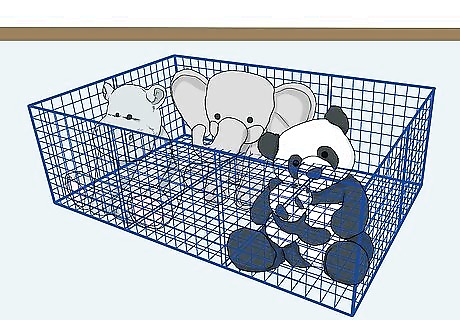
Use a toy cage. Toy cages, or toy pens, are tall open crates that can be used to store as many as 100 stuffed animals at a time. The toys get piled on top of each other, and the open slats or bars that keep the animals contained also allow children to access the toys and put them back. For a small animal pen, you can use a large basket with wide spaces between the bars. For a quick DIY animal zoo, take the shelves out of a bookcase and tie string or twine horizontally or vertically around the bookcase like bars. Fill the bookcase with stuffed animals and position the twine to keep them in place.
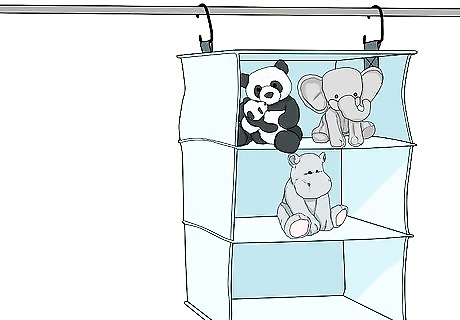
Store them in hanging organizers. You can use over-the-door shoe organizers or hanging closet organizers to store stuffed animals. Over-the-door organizers are generally better for smaller toys, whereas closet organizers will be able to hold larger stuffed animals.
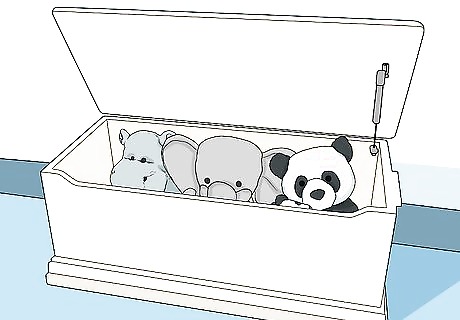
Use a toy chest. Toy chests come in all shapes and sizes, and they are excellent and beautiful pieces of furniture that can be used for all sorts of storage as your child ages. Old crates can also double as rustic toy chests, and crates on wheels make for excellent portable toy storage units.

Hang a toy hammock. Toy hammocks can be hung from hooks on the wall or ceiling in your child’s room, and larger ones can be used to house many toys. You can use a toy hammock, a net, or even an old blanket for the purpose. If you like to crochet, you might consider making your own toy hammock! Most toy hammocks work best when they are suspended in corners, and from three separate hooks (one on each adjoining wall and one near the corner).
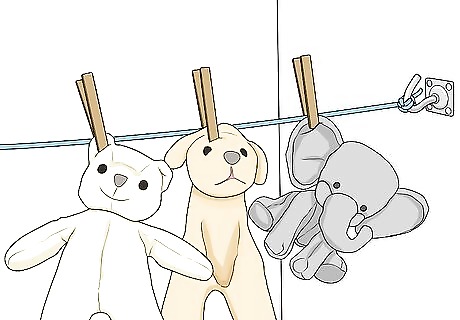
Hang a clothesline for toys. Use hooks on opposite walls to run a clothesline along a wall in your child’s room. Then, you can use clothes pegs to fasten stuffed animals to the line. For the clothesline itself, you can use yarn, string, or twine. Make sure you hang the line somewhere that your child won’t accidentally run into it.
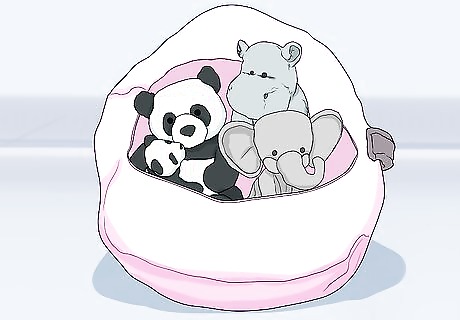
Use them as stuffing for a bean bag chair. You can buy or make a bean bag chair shell that is just fabric with a zipper that’s designed to be stuffed. Instead of using cotton batting or other stuffing, fill the bean bag shell with plush animals. That way, the stuffed animals are contained, easily accessible, and are turned into a functional piece of furniture.
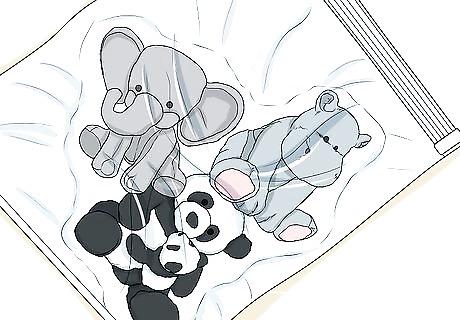
Vacuum seal them. For stuffed animals that your child won’t be using any time soon, stuff the toys into vacuum bags. Then, use your vacuum cleaner nozzle to suck the air out of the bag, thereby reducing the space the animals take up. Because this method can squish and misshape stuffing, don’t use vacuum bags for precious stuffed animals or antique plush toys, as they could be damaged by the process.
Making an Animal Cage
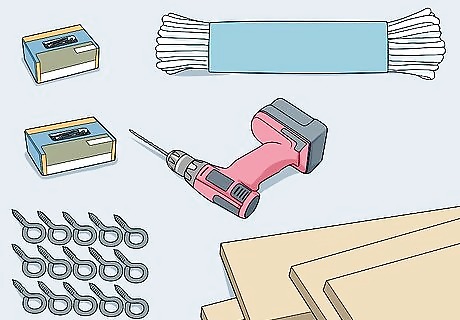
Gather your supplies. For this project, you will need four sanded pillars of wood that are cut to six feet tall and two inches by two inches wide. You will also need: One box of two-inch screws One box of three-inch screws 15 screw eyes A 40-foot length of rope A drill Six pieces of sanded wood that are 12 inches long and 2 ½ by ¾ inches Five front railings that are 32 inches long and 2 ½ by ¾ inches One piece of fascia that’s 32 inches long and 8 by ¾ inches
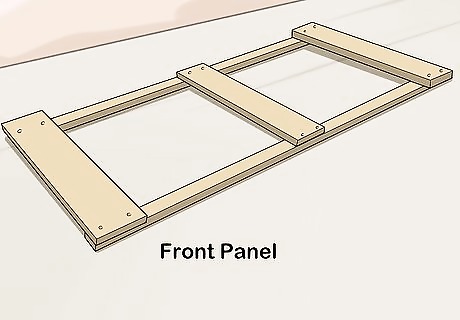
Put together the front panel. Lay out two of the six-foot pillars on the ground, 32 inches apart. At the bottom of the pillars, lay down a front railing that will connect them. On the right side, pre-drill two screw holes through the front railing and the pillar. Repeat on the other side. Once you’ve pre-drilled the holes, attach the front railing to the bottom of the pillars with the two-inch screws. Repeat these same steps with a front railing at the very center of the pillars. At the top of the pillars, attach the piece of fascia.
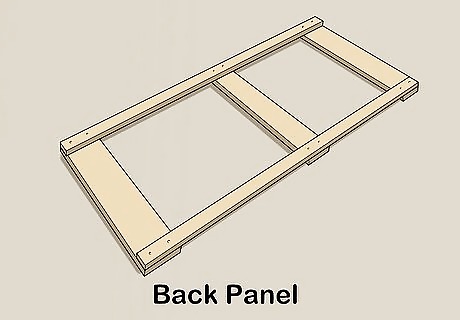
Put together the back panel. Repeat the same steps that you did for the front panel, but use front railing at the top, center, and bottom.
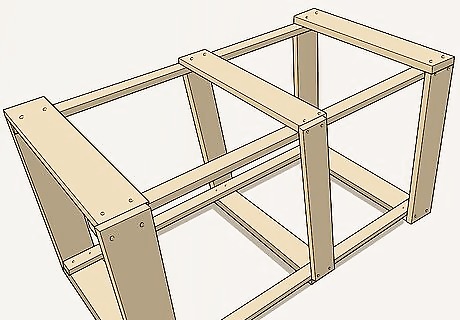
Attach the front and back together. Start with the back panel, and attach a piece of 12-inch board at the top, center, and bottom on both sides of the back panel. Use the three-inch screws, and make sure the 12-inch boards are attached perpendicular to the back panel. Once you have the 12-inch boards attached on either side of the back panel, attach the front panel to the 12-inch boards using the three-inch screws.
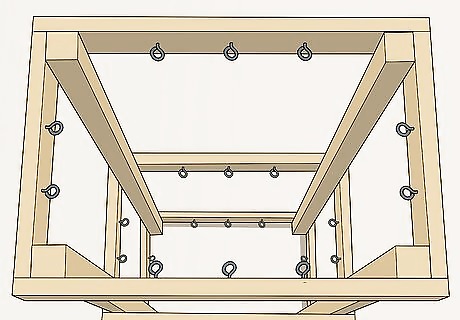
Attach the hooks. On the front panel, you’re going to place three hooks on the fascia, three hooks on the center railing, and three hooks on the bottom railing. Pre-drill holes for the hooks, spacing the holes out evenly across the length of the boards. Each 12-inch board on the side panels will get one hook in the center, so pre-drill the holes for that. Once the holes are drilled, screw in the hooks.
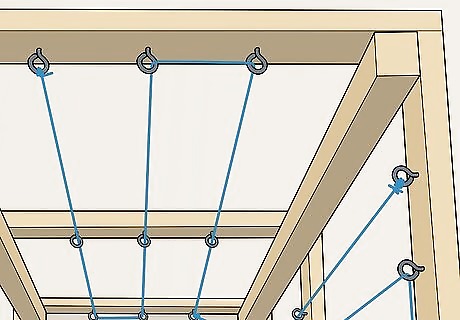
Run the rope. You're going to use the hooks to run the rope through the cage to create the bars. Tie a large knot at one end of the rope. Run the other end of the rope through the hook on the bottom side panel on the left. Pull the rope all the way through so the knot catches on the first hook. Run the rope through the center hook on the same side panel, then through the top hook. Thread the rope across the top side railing and then run it down through the first hook on the fascia, followed by the hook on the center railing below, then the hook on the bottom railing below that. Then run the rope across to the middle set of hooks and repeat. Repeat these steps until you have three sets of bars across the center panel and one set of bars on each side panel. When you’ve finished running the rope, cut the excess and tie a knot in the end to secure it in place.
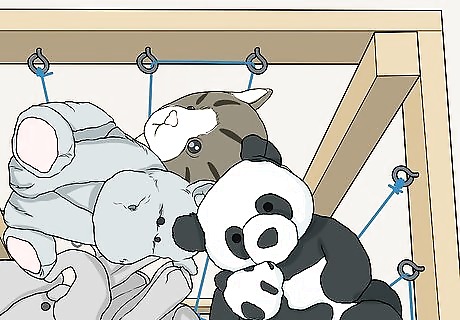
Decorate and fill the zoo. After you decorate the zoo (you can paint it, add stickers, or leave it plain), position it with the back against a wall. Once dry, fill it with your stuffed animals. The rope bars will make it easy to access animals and put them back.




















Comments
0 comment